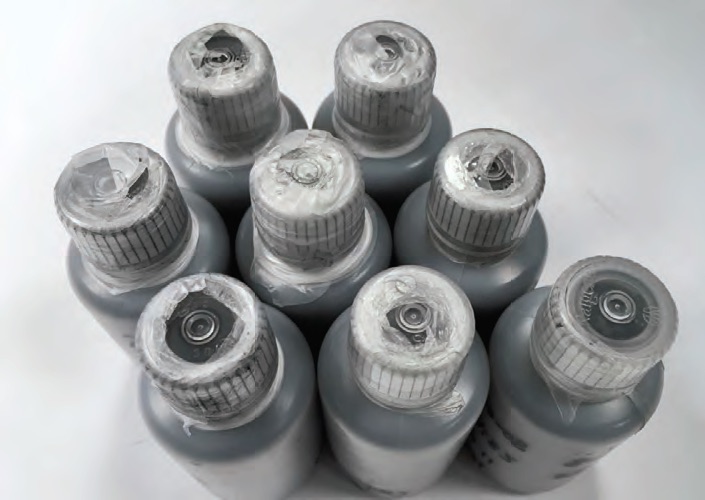Cobalt provides important performance characteristics to lithium-ion battery cathodes but has a number of negative characteristics.
A high-nickel lithium oxide known as NMA has been found to display promising results as a cobalt-free cathode.
Two of the metals used in NMA, manganese and aluminum, stabilize the cathodic material and ensure that energy density is not sacrificed.
The development of lithium-ion batteries for use in applications such as electric vehicles has been continuing with much of the attention focused on finding a substitute for the graphite electrode used as the anode. But attention also is being paid to the cathode because of the challenge of identifying and commercializing an alternative for the cobalt used in the cathode.
In a previous TLT article,
1 researchers determined that vanadium disulfide is a cobalt-free candidate once this material is stabilized. Lattice distortion of the vanadium disulfide was found to be the cause of poor cathode stability, leading to low cycle life. Application of a thin layer of titanium disulfide on the vanadium disulfide produced a cathode that can contribute to a more rapid charge/discharge cycle than the currently used cathodic material, lithium cobalt oxide.
Arumugam Manthiram, professor in the J. Mike Walker department of mechanical engineering and director of the Texas Material Institute at the University of Texas in Austin, Texas, says, “Cobalt has been known to provide good cycle life, a stable crystal structure and a good rate at which the cathode can be charged or discharged. This element facilitates good electrical and ionic conductivity in the cathode. Cobalt also suppresses the mixing of lithium ions with the other metal ions in different layers in the crystal structure.”
But continuing to use cobalt presents concerns for a number of reasons. Cobalt is in relatively short supply globally with much of this transition metal mined in a specific region. Demand for cobalt should continue to grow as use of electric vehicles increases. Manthiram indicates that the main cathodic material used in electric vehicles is NMC-622, which is a combination of oxides of lithium, nickel, manganese and cobalt. The amount of cobalt used in an electric vehicle is greater than 200 grams per kilowatt hour. The result is cobalt will continue to be an expensive raw material unless it is replaced.
Efforts to reduce, if not eliminate, the cobalt content in cathodes have not been successful. Manthiram says, “Cathodic materials without cobalt have suffered from poor rate capability and poor cycling. For example, use of manganese enhances the mixing of lithium and nickel without the presence of cobalt to counterbalance this effect. These metals ions in the absence of cobalt can lead to structural defects and deteriorating electrochemical properties.”
The key to an effective cobalt-free cathode is compositional design, according to Manthiram.
One class of materials that has potential is high-Ni-layered oxides. Manthiram and his colleagues have now determined that this material type is a potential path to eliminate cobalt.
High-nickel NMA
The researchers synthesized a high-nickel lithium oxide known as NMA that also contains manganese and aluminum. High-nickel NMA was prepared by metal hydroxide coprecipitation followed by lithiation calcination (
see Figure 1). Manthiram says, “The base cathodic material used, NMC, has a nickel content of 60%. In the case of high-nickel NMA, the nickel content is 89%. For this reason, we consider high nickel to mean materials with nickel contents between 80% and 90%.”
 Figure 1. NMA was prepared through a two-step process, and the powder samples shown here were used in preparing a cobalt-free cathode. Figure courtesy of the University of Texas.
Figure 1. NMA was prepared through a two-step process, and the powder samples shown here were used in preparing a cobalt-free cathode. Figure courtesy of the University of Texas.
High-nickel NMA was evaluated versus other cathodic materials including NMC, NCA (a lithium nickel cobalt aluminum oxide) and NMCAM (NMC co-doped with aluminum and magnesium). Analytical techniques including X-ray diffraction (XRD), inductively coupled plasma optical emission spectrometry (ICP-OES), energy dispersive X-ray spectrometry (EDX) and scanning electron microscopy (SEM) were used to characterize the four materials.
Analysis of the electrochemical capabilities of high-nickel NMA were initially carried out with coin half cells paired with lithium metal anodes. The researchers cycled the cathodes every three hours. After 100 cycles, the high-nickel NMA retained 90% of its capacity, which is comparable to the other three cathodic materials. When the cathodes were cycled every 30-60 minutes, the high-nickel NMA achieved a comparable retention rate to NMCAM and a superior rate to NMC and NCA.
Manthiram says, “Manganese and aluminum stabilize the structure of the high-nickel NMA by suppressing side reactions. Both were chosen to ensure that high-nickel NMA has a lower cost and energy density is not sacrificed. Aluminum proved to be important as a nonmagnetic element that could stabilize nickel and the structure. This is one of the roles that cobalt performs in the current cathode.”
Another positive feature of high-nickel NMA is the material’s heat stability, which was evaluated using differential scanning calorimetry (DSC). Future work involves a post-mortem study that is underway to analyze the cathodes used in the cell cycling studies. Manthiram says, “We are trying to understand the degradation reactions that occurred in all four cathodes and how high-nickel NMA displayed superior long-term cycling in the absence of cobalt.”
Manthiram is optimistic about the future use of high-nickel NMA and believes this material has the potential to replace NMC in the future. Additional information can be found in a recent article
2 or by contacting Manthiram at
rmanth@mail.utexas.edu.
REFERENCES
1. Canter, N. (2019), “Potential new cathode material for a lithium-ion battery,” TLT, 75 (7), pp. 16-17.
2. Li, W., Lee, S. and Manthiram, A. (2020), “High-Nickel NMA: A Cobalt-Free Alternative to NMC and NCA Cathodes for Lithium-Ion Batteries,”
Advanced Materials 32 (33), Article Number: 2002718